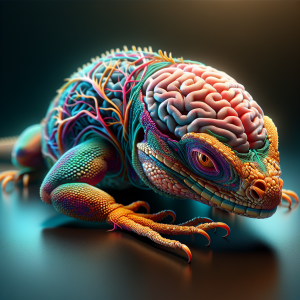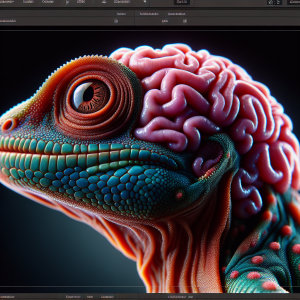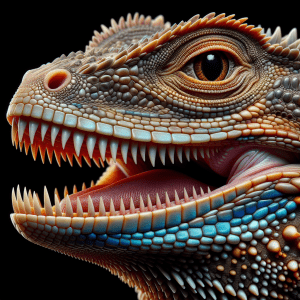Introduction to Lizard Muscular Anatomy
Imagine diving into the captivating world of lizard muscular anatomy, where every muscle tells a unique story. Have you ever stopped to ponder the incredible complexity of a lizard’s muscular system? Picture this: a tiny gecko scaling walls effortlessly, thanks to its powerful muscles working in perfect harmony. It’s truly a marvel of nature, isn’t it? The muscular anatomy of lizards is a fascinating subject that offers a glimpse into the evolutionary adaptations and survival strategies of these remarkable creatures. From the lightning-fast strikes of a chameleon’s tongue to the incredible jumping abilities of a basilisk lizard, every movement is powered by a intricate network of muscles. Did you know that some lizards can regenerate lost muscle tissue, showcasing the remarkable regenerative capabilities of these creatures? It’s a testament to their resilience and adaptability in the face of challenges. As we delve deeper into the world of lizard muscular anatomy, we uncover not just the biological intricacies but also the broader implications for conservation and scientific research. By understanding and appreciating the nuances of their muscular systems, we gain a deeper appreciation for the diversity and ingenuity of the natural world. So, are you ready to embark on this exhilarating journey through the hidden world of lizard muscles? Get ready to be amazed!
Importance of Understanding Lizard Muscles
Lizard muscles may not be something you think about daily, but trust me, they’re fascinating. Let’s dive into the world of lizard muscular anatomy, and you’ll be amazed at what these creatures can do.
Imagine a tiny gecko clinging effortlessly to a wall. That’s the magic of lizard muscles. They’re incredibly efficient and powerful, allowing these creatures to perform jaw-dropping acrobatics in their natural habitats.
Now, here’s an interesting fact for you: Did you know that some lizards can regenerate their muscles? It’s true! Certain species have the remarkable ability to regrow lost muscle tissue, a skill that has scientists captivated.
Understanding lizard muscles isn’t just about appreciating their physical prowess. It also sheds light on evolutionary adaptations and survival strategies that have been honed over millions of years.
So, why does studying lizard muscular anatomy matter? Well, aside from the sheer cool factor, it can provide valuable insights into biomechanics, ecology, and even potential medical applications for humans.
Imagine if we could harness the regenerative powers of lizard muscles for medical advancements. The possibilities are endless, and it all starts with a deeper understanding of these incredible reptilian physiques.
So, grab your magnifying glass and let’s embark on a journey into the mesmerizing world of lizard muscular anatomy. Trust me; you won’t be disappointed!
Overview of Lizard Muscle Types
Have you ever stopped to think about the incredible diversity in lizard muscle types? It’s truly fascinating! These remarkable creatures possess a wide array of muscle types, each serving a specific function that aids in their survival and agility.
Lizards have both smooth and striated muscles, similar to humans, but they also have a unique muscle type called tonic muscle. This type of muscle allows lizards to maintain a prolonged contraction without fatiguing, which is crucial for activities like clinging to surfaces or holding a specific posture for extended periods.
Imagine the incredible strength and endurance required for a lizard to scale vertical surfaces or leap from branch to branch with such precision. Their muscular system is finely tuned to meet these demands, showcasing the remarkable adaptations that have evolved over millions of years.
Understanding the intricacies of lizard muscle types not only sheds light on their physical capabilities but also provides valuable insights into their behavior and ecological roles. By delving into the world of lizard muscular anatomy, we gain a deeper appreciation for these fascinating creatures and the wonders of nature’s design.
So, the next time you observe a lizard darting across the ground or perched on a tree limb, take a moment to marvel at the complexity of their muscular system and the extraordinary adaptations that allow them to thrive in diverse environments.
Adaptations of Lizard Muscles
Ever wondered how lizards’ muscles enable them to perform incredible feats of agility and strength? Let’s dive into the fascinating world of lizard muscular anatomy and discover the secrets behind their impressive abilities.
Lizard muscles are not just your average muscles. They are finely tuned machines that allow these creatures to scale vertical surfaces, leap across vast distances, and even change color to blend seamlessly into their surroundings. Imagine having muscles that versatile!
One interesting fact about lizard muscles is that they have evolved to meet the unique demands of their environments. From the powerful leg muscles of monitor lizards to the lightning-fast tongue muscles of chameleons, each species has its own specialized adaptations for survival.
These remarkable adaptations raise a thought-provoking question – how can we apply the principles of lizard muscular anatomy to enhance human technology and robotics? Perhaps studying the biomechanics of lizards could inspire breakthrough innovations in the field of robotics, leading to more agile and efficient machines.
As we unravel the intricacies of lizard muscular anatomy, we not only gain a deeper appreciation for these incredible creatures but also open doors to exciting possibilities for future research and technological advancements. So, next time you see a lizard scurrying up a wall or darting across the ground, take a moment to marvel at the wonders of nature’s design in action.
Comparison to Other Reptile Muscular Systems
Have you ever stopped to think about the sheer power and complexity of lizard muscles? These creatures may appear small and unassuming, but their muscular anatomy is truly a marvel of evolution.
Lizard muscles play a crucial role in their survival, allowing them to move swiftly and with precision. Consider the agility of a gecko effortlessly scaling walls or the lightning-fast strike of a chameleon catching its prey – all thanks to their remarkable muscles.
One fascinating aspect of lizard muscular anatomy is their ability to regenerate muscle tissue. Unlike humans, lizards have a remarkable capacity to repair and regrow damaged muscle fibers, enabling them to recover quickly from injuries.
This remarkable regenerative ability has caught the attention of researchers worldwide, sparking interest in potential applications for human medicine. Could studying lizard muscle regeneration hold the key to developing new treatments for muscle injuries in humans?
The intricacies of lizard muscular anatomy offer a glimpse into the incredible diversity and adaptability of life on Earth. Next time you observe a lizard darting across the ground or basking in the sun, take a moment to appreciate the impressive biomechanical wonders at work within their muscles.
Factors Influencing Lizard Muscle Function
Have you ever wondered what sets lizard muscles apart from other reptiles? Let’s dive in.
Lizard muscles are incredibly versatile – enabling them to scurry up walls and leap great distances.
Their muscles are finely tuned machines, responding to quick bursts of energy for rapid movements.
The ability of lizard muscles to contract powerfully and swiftly is a sight to behold.
Picture this: a gecko dashing up a vertical surface with effortless agility – all thanks to its remarkable muscles.
Understanding the intricacies of lizard muscles can provide valuable insights into their unique locomotion abilities.
Did you know that some lizards can regenerate muscle tissues after injury, a fascinating adaptation?
This remarkable ability showcases the resilience and adaptability of these incredible creatures.
Imagine the possibilities if we could harness the regenerative powers of lizard muscles for medical advancements.
Exploring the wonders of lizard muscular anatomy unveils a world of innovation and inspiration.
Common Muscular Disorders in Lizards
Muscular disorders in lizards may sound like a downer, but bear with me, folks. It’s not all doom and gloom in the world of reptile muscles. In fact, understanding these disorders can shed light on broader issues that impact lizard health and conservation efforts. Take the common muscular disorder known as “muscle wasting,” for instance. This condition can affect a lizard’s ability to move, hunt, and survive in its natural habitat. It’s like having a flat tire when you’re trying to win a race – not ideal, right? By studying these muscular challenges, researchers can develop strategies to help lizards facing similar issues in the wild. Imagine being the hero who saves the day for a lizard in distress! So, the next time you come across a lizard struggling with muscle problems, remember that there’s more to the story than meets the eye. It’s a reminder that even the smallest creatures play a vital role in the intricate web of life on our planet. Who knew lizard muscles could hold such significance beyond their scaly exterior? It’s a reminder that nature is full of surprises and lessons waiting to be uncovered.
Studying Lizard Muscular Anatomy in Research
When it comes to studying lizard muscular anatomy in research, it’s like embarking on a thrilling adventure into the hidden world of these fascinating creatures. Imagine delving deep into the intricate details of how their muscles work, almost like solving a captivating puzzle that nature has carefully crafted over millions of years.
You see, every aspect of a lizard’s muscular system holds valuable insights waiting to be uncovered. From the unique adaptations that allow them to scale rocks effortlessly to the subtle differences that set them apart from other reptiles, each discovery opens a new window into their evolutionary journey.
As you navigate through the realm of lizard muscles, it’s not just about unraveling scientific mysteries – it’s about gaining a profound appreciation for the beauty of nature’s design. The more we understand these creatures on a muscular level, the more we realize the interconnectedness of all living beings on our planet.
So, the next time you observe a lizard darting across your path, take a moment to marvel at the incredible complexity of its muscular anatomy. It’s a reminder of the wonders that await us when we peer beneath the surface and explore the hidden realms of the natural world.
Conservation Implications of Lizard Muscular Anatomy
Conservation Implications of Lizard Muscular Anatomy
When we delve into the world of lizard muscular anatomy, we uncover not just fascinating biological intricacies, but also profound implications for conservation efforts. Imagine this – the unique muscle adaptations in certain lizard species have enabled them to thrive in diverse environments, showcasing the remarkable power of evolution.
Consider this interesting fact: the muscular structure of lizards plays a crucial role in their ability to adapt to changing habitats and climates. By studying how these muscles function and evolve, scientists gain valuable insights into the resilience of these reptiles in the face of environmental challenges.
Now, let’s ponder the broader significance of understanding lizard muscular anatomy for conservation. As human activities continue to impact natural ecosystems, preserving biodiversity becomes more critical than ever. By unraveling the secrets held within lizard muscles, we not only deepen our knowledge of these creatures but also enhance our ability to protect their habitats and ensure their survival for future generations.
So, next time you observe a lizard darting across your path, take a moment to appreciate the intricate muscular system that powers its movements. By valuing and safeguarding these remarkable creatures, we contribute to the rich tapestry of life on our planet.
Conclusion and Future Perspectives
Have you ever stopped to marvel at the incredible complexity of lizard muscular anatomy? These magnificent creatures possess a muscular system that is finely tuned to aid in their survival and unique way of life.
Lizards are true marvels of nature, equipped with muscles that allow them to perform astonishing feats. From the powerful leg muscles that enable them to leap great distances to the intricate muscles in their tongues that help them catch prey with lightning speed, these creatures are a testament to the wonders of evolution.
Take a moment to imagine yourself as a lizard, navigating the world with agility and grace, relying on your muscles to propel you forward and conquer any obstacle in your path. It’s truly a fascinating thought, isn’t it?
As an expert in lizard muscular anatomy, I have spent years studying these remarkable creatures and unraveling the secrets of their muscular systems. Every new discovery brings me closer to understanding the intricate workings of these creatures and the unique adaptations that have allowed them to thrive in diverse environments.
So, the next time you encounter a lizard basking in the sun or darting across the forest floor, take a moment to appreciate the incredible complexity of its muscular anatomy. It’s a testament to the beauty and diversity of the natural world, and a reminder of the wonders that await those who dare to explore.




